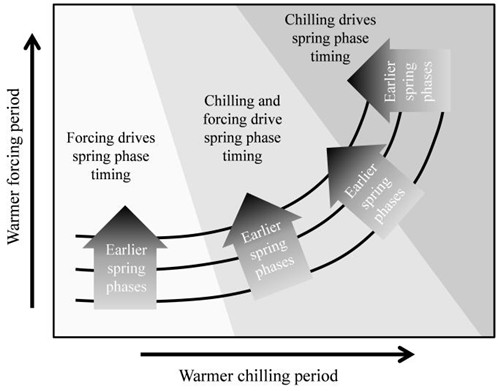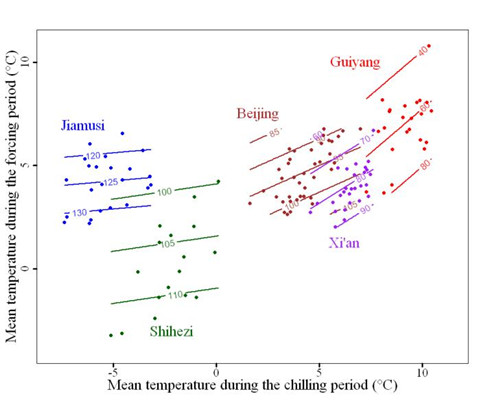Variation in plant phenology is one of the most sensitive ecological responses to climate change. Changes to species’ phenology can have a wide range of impacts on ecological processes, agriculture, forestry, food supply, and human healthy. Most studies that evaluated species responses to global warming have shown progressive advances in spring phenology. However, unchanged and delayed spring events have also been reported.
How to explain the different responses of trees to warming? The research group led by Prof. XU Jianchu from Kunming Institute of Botany , has conducted long-term studies on climate change, and gave a hypothesis on this issue. The timing of spring phenology in most temperate plants results from the combined effects of both autumn/winter cold and spring heat. Temperature increases in spring can advance spring phases, but warming in autumn and winter may slow the fulfillment of chilling requirements and lead to later onset of spring events. As warming continues, the phenology-delaying impacts of higher autumn/winter temperatures may increase in importance, and could eventually attenuate – or even reverse – the phenology-advancing effect of warming springs that has dominated plant responses to climate change so far.
To test this hypothesis, the researchers evaluated the temperature responses of apricot bloom at five climatically contrasting sites in China. Results indicated that in cold climates, spring timing of apricots is almost entirely determined by forcing conditions, with warmer springs leading to earlier bloom. However, for apricots at warmer locations, chilling temperatures were the main driver of bloom timing, implying that further warming in winter might cause delayed spring phases. As global warming progresses, current trends of advancing phenology might slow or even turn into delays for increasing numbers of temperate species.
This research results have been published on line in Agricultural and Forest Meteorology (Top One journal in Forestry) with a title named ‘Responses of spring phenology in temperate zone trees to climate warming: A case study of apricot flowering in China’ (http://www.sciencedirect.com/science/article/pii/S0168192314002676).
This research was supported by the National Key Basic Research Program of China (No. 2014CB954100), and another two National Natural Science Foundation of China (NSFC)’s projects (No: 31270524 and 41030101). Further support was supplied by the Consultative Group on International Agricultural Research.

Fig. 1 Hypothesis. ( Image by KIB)

Fig. 2 Response of apricot bloom to warming at 5 locations .( Imge by KIB )




